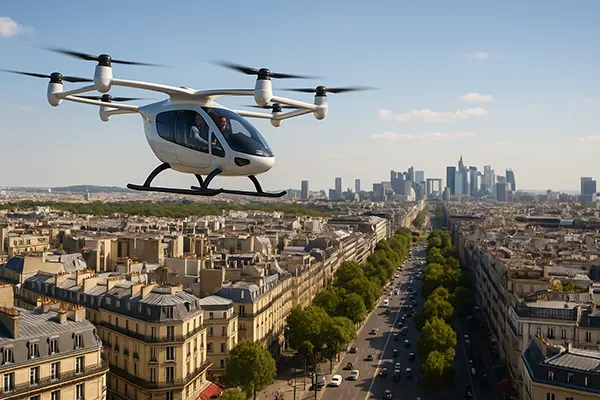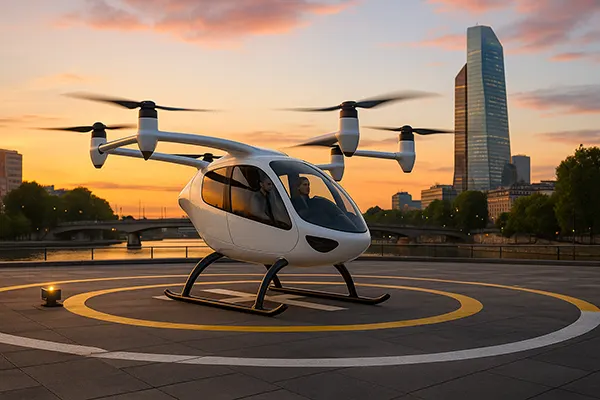Drone Taxis in Europe: When Will Urban Flights Begin?

As European cities continue to modernise their infrastructure and embrace smart mobility, the question of when drone taxis will finally take to the skies becomes increasingly relevant. Once considered a sci-fi fantasy, air taxis are now undergoing certification, trials, and regulatory scrutiny across the EU. By mid-2025, several countries are preparing to launch commercial or demonstration flights above urban environments. This article explores the real status of drone taxi development in Europe, including timelines, regulatory hurdles, and technical readiness.
Regulatory Foundations and Approvals Across the EU
The European Union Aviation Safety Agency (EASA) is spearheading a unified regulatory approach to urban air mobility (UAM). In January 2024, EASA published its final version of the “Special Condition for VTOL” framework, which outlines the certification criteria for vertical take-off and landing aircraft. This move has enabled aircraft manufacturers such as Volocopter, Lilium, and Airbus to prepare for public demonstrations.
France and Germany are currently the most advanced in terms of integrating drone taxis into their regulatory frameworks. Volocopter has received provisional design approval, while Paris authorities are actively working with aviation regulators to integrate air taxis into the city’s airspace during the 2024 Olympic Games — a major testing milestone.
Additionally, the EU’s U-Space regulations, effective since January 2023, are creating the foundation for safe, automated drone traffic management across member states. This infrastructure is essential for real-time traffic control of air taxis and other unmanned aircraft in dense urban zones.
Country-Specific Plans and Timelines
Germany’s Volocopter is on track to launch its first crewed air taxi services in Paris and Rome between late 2024 and mid-2025. The French Civil Aviation Authority (DGAC) has allocated five vertiports around Paris for this purpose. These routes will connect major hubs like Charles de Gaulle Airport, Issy-les-Moulineaux, and the business district of La Défense.
In Italy, Rome is preparing infrastructure for vertical mobility at Fiumicino Airport. The Italian aviation authority ENAC has signed multiple public-private agreements to enable commercial operations by 2025. Spain and the Netherlands are also progressing, with drone taxi testing expected in Barcelona and Amsterdam later this year.
Despite this progress, commercial viability will depend on successful integration with air traffic control systems, security protocols, and public acceptance. Several cities plan public awareness campaigns to introduce the concept and explain safety procedures to residents.
Technological Advancements Behind Urban Air Mobility
Electric Vertical Take-Off and Landing (eVTOL) aircraft are at the heart of this revolution. These vehicles are designed to be quieter, safer, and more sustainable than helicopters. Manufacturers like Joby Aviation, Lilium, and EHang have made significant progress in increasing battery life, improving autonomous navigation, and reducing noise pollution.
Volocopter’s VoloCity model, for instance, has undergone extensive flight testing and recently completed successful piloted demonstrations in Paris. The aircraft offers space for one passenger and a pilot, with a planned range of 35 km and a cruise speed of 110 km/h — suitable for short intercity hops.
Lilium’s electric jet technology, however, targets longer regional connections, potentially expanding drone taxi use beyond urban cores. By using ducted fans and fixed wings, Lilium’s aircraft could eventually replace some short-haul flights between nearby cities like Munich and Zurich.
Infrastructure and Charging Networks
The success of air taxi operations depends not just on vehicles but also on ground infrastructure. Vertiports — designated landing and take-off hubs — are being developed across major European airports and central locations. These hubs require integrated charging systems, passenger lounges, and automated maintenance zones.
Companies like Skyports and UrbanV are leading the construction of these vertiports, while partnerships with local governments aim to secure strategic rooftop and urban land locations. In Paris, the vertiport at Issy-les-Moulineaux is already under construction with operational tests planned for Q4 2024.
Additionally, energy providers are working to deliver fast-charging stations compatible with eVTOL aircraft. Since each flight consumes significant battery power, ensuring turnaround efficiency is crucial to commercial scaling.

Public Perception, Safety and Urban Integration
Safety remains a central concern for citizens and regulators alike. EASA mandates rigorous airworthiness certification, emergency landing protocols, and redundancy in critical systems. Moreover, air taxis must meet strict noise pollution thresholds and adhere to airspace deconfliction rules to prevent mid-air collisions.
To gain public trust, operators are running extensive pilot programmes and simulations. In June 2025, test flights with volunteer passengers are scheduled in both Paris and Rome, accompanied by live demonstrations at public events to showcase safety features and vehicle reliability.
Integration into cityscapes also requires close coordination with urban planners. Municipalities must ensure vertiports don’t disrupt existing transport systems or residential areas. Furthermore, discussions around equitable access and pricing models are underway, ensuring the service doesn’t remain exclusive to affluent users.
When Will Passengers Take Flight?
The current projection suggests that limited commercial operations will begin in selected European cities by mid to late 2025. These flights will likely be short-distance routes with fixed paths and manually piloted vehicles, operated under strict regulatory oversight.
By 2026–2027, wider adoption is expected, including autonomous flights, on-demand booking systems, and intercity routes. The pace of development will depend on safety validation, cost-efficiency, and real-time data integration across European airspace.
In summary, drone taxis in Europe are no longer a question of “if” but “when.” As cities prepare the infrastructure and technology matures, the skies above European capitals may soon host the next generation of urban mobility.
